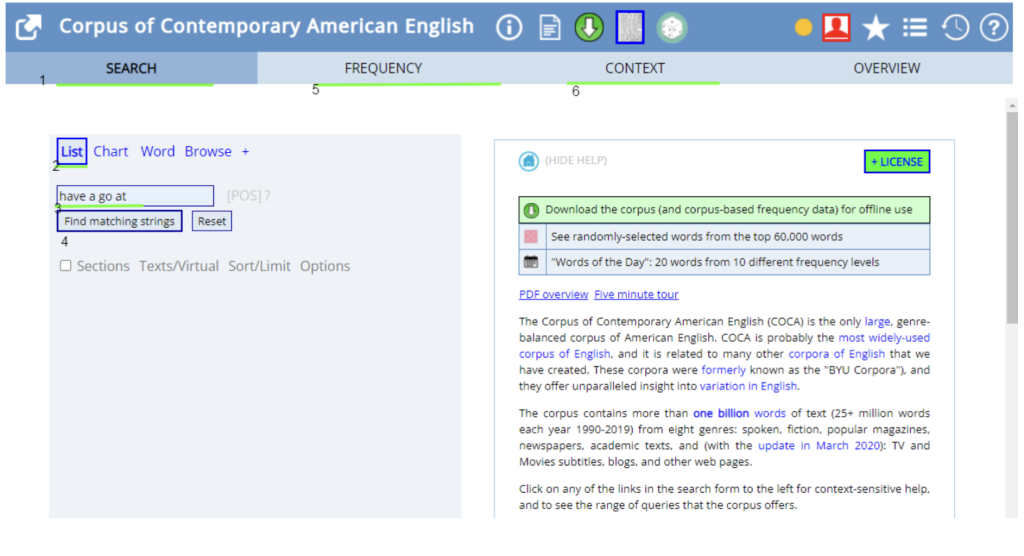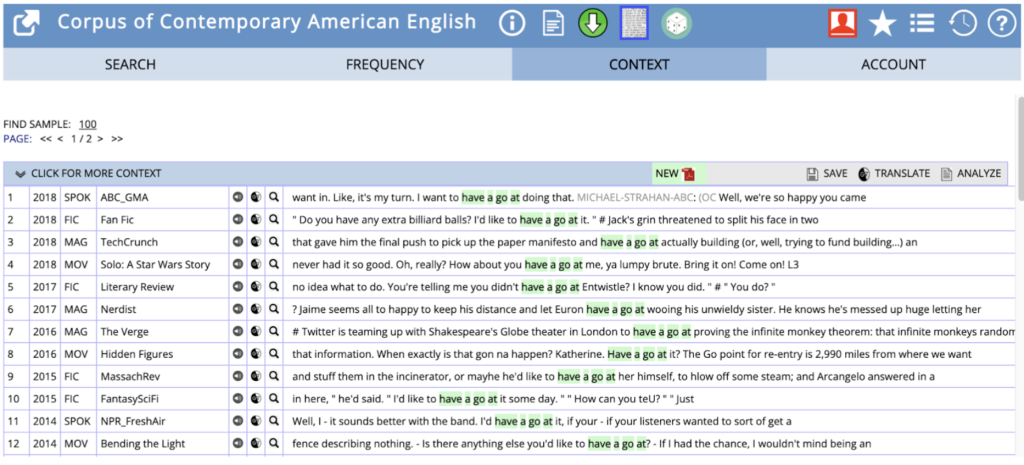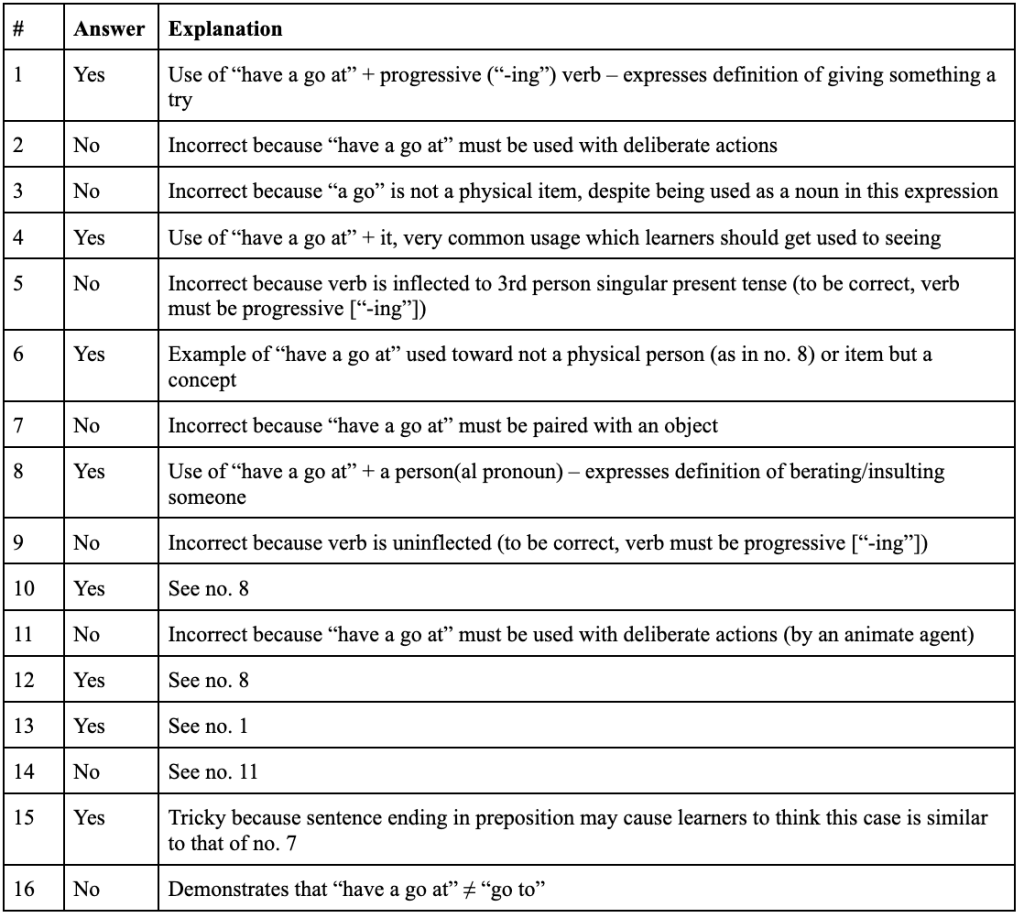13. ‘Have a go’ at COCA: Using corpus tools to learn more about expressions in English
Lívia Leote and Catie DeRienzo
Lívia Leote
Undergraduate student at Federal University of Rio Grande do Sul
Catie DeRienzo
Undergraduate student at Montclair State University
Goals: To understand the English phrase “have a go at” in different contexts with the help of corpus tools.
Audience: Intermediate learners of English, varying from high school to adult-level classes.
Duration: 25-30 minutes
INTRODUCTION
All languages, be it Portuguese, English, or Russian, have idiomatic expressions that may confuse learners of that language upon hearing them for the first time. In Portuguese, for example, we have the idiomatic phrase “deixa comigo” which roughly translates to “leave it to me” in English. After hearing this phrase, many learners of Brazilian Portuguese are often left asking “leave what?” or “where exactly?” Phrases like these are often difficult to understand because they have no congruent expression in one’s original language.
This task will focus on exploring the meanings of “have a go at” and demystifying its use in context. This phrase can be used in more than one context, and with the help of corpus tools, learners of English can find the meaning of this expression in different contexts.
STEP 1: CORPUS ANALYSIS
In the first part of this lesson, teachers can use the Corpus of Contemporary American English (COCA) to investigate the use of this phrase in context. COCA is a free platform which contains a huge collection of texts in Standard American English.
Once logged in to COCA, the teacher should follow these steps:
- Step 1: Click on the “search” button in the navigation bar. This will open a page with two boxes: the first one is for conducting searches and the second one is for help.
- Step 2: Select “list” at the top of the first box and write “have a go at” on the main input. Click “find match strings” to view the search results.

Figure 1 – COCA search for “have a go at”
- Step 3: Select the “frequency” button on the navigation bar. A table will appear on this page and you’ll read “ALL FORMS (SAMPLE)”. On this screen, click on the number 100 that is following the writing.
- Step 4: Select the “context” button on the navigation bar. The results will show different examples of the phase being used in context.

Figure 2 – COCA context search results for “have a go at”
Looking at the concordance lines shown in Figure 2, we can see that the phrase in question usually means “to try” or “to attempt”. For example, in the third sentence of the concordance lines, we see “Do you have any extra billiard balls? I’d like to have a go at it“. In this sentence, we could replace the expression “have a go at” with “try”.
In most of the concordance lines, the verb is followed by the pronoun it plus a verb in the gerund (like in the first sentence, which says “I’m having to really have a go at rewiring it”), or a noun. But, sometimes, the expression “have a go at” will be followed usually by object pronouns, so the meaning of the expression can change a bit.You can see this in the fourth sentence, which says “Oh, really? How about you have a go at me, ya lumpy brute. Bring it on!”. In this case, the expression means to scold.
During the lesson, the teacher should discuss the expression with the class, being sure to mention what the expression means and what words could follow it. They could either open COCA with the students, or print COCA screenshots to explain the use of this expression to students.
STEP 2: PRACTICE ACTIVITY
Activity #1
The goal of this task is to get you to practice using “have a go at” and to understand the different parts-of-speech that can follow this word. Below are concordance lines taken from the COCA corpus. For each sentence below, match the half sentences using “have a go at” to the correct phrase that completes the sentence best after it.
( ) I would never ever criticize anybody’s faith and never – never have a go at…
( ) I’m sorry mate, I didn’t mean to have a go at…
( ) Want to come tomorrow and have a go at…
( ) I don’t think he’s even aware of it himself. Let me have a go at…
( ) It had been a long time since he’d last done it. That’s why I didn’t suggest he have a go at…
( ) Do you have any extra billiard balls? I’d like to have a go at…
( ) I love the feeling. You can have a go at…
1) …it.
2)…you. He said. I assured him that it was okay.
3)…him. […] I doubt that he’s thought through any of that.
4)…the garage with me? If it’s filth you want, you can’t get much grubbier than that.
5)…anybody because of their faith.
6)…the pin and feel confident the ball is going exactly where you’ve planned.
7)…it now. A crash probably wouldn’t hurt us any more than a wild animal would, but it would screw up[…].
Activity #2:
Do the following sentences use the phrase “have a go at” correctly? Write “yes” next to the sentences that use the phrase correctly, and “no” next to the ones that do not.
- I decided to have a go at making crumpets for him.
- Sometimes I have a go at falling down the stairs since I’m so clumsy.
- I used to have a go at my house, but then I brought it to my friend’s house.
- Care to have a go at it for old times’ sake?
- She wants to have a go at draws a portrait of her boyfriend for Valentine’s Day.
- I think historians will have a go at his reputation when the eulogies are over.
- “My wife and I are excited to be here,” I said, “because we really want to learn the culture and have a go at.”
- If somebody wants to have a go at me, that’s fine as far as I’m concerned.
- Guillermo wants to have a go at to run a marathon this weekend.
- It isn’t really fair to have a go at him for getting the numbers wrong.
- A mature tree will have a go at blooming every spring.
- “I’m sorry mate, I didn’t mean to have a go at you,” he said.
- I have to really have a go at rewiring it because it is indeed very old.
- It seems like the light bulb is ready to have a go at burning out.
- It’s about the once-in-a-lifetime experiences we get the chance to have a go at.
- I was thinking I’d have a go at the grocery store later today to buy some eggs.
Answers
Exercise 1: 5-2-4-3-7-1-6
Exercise 2:

